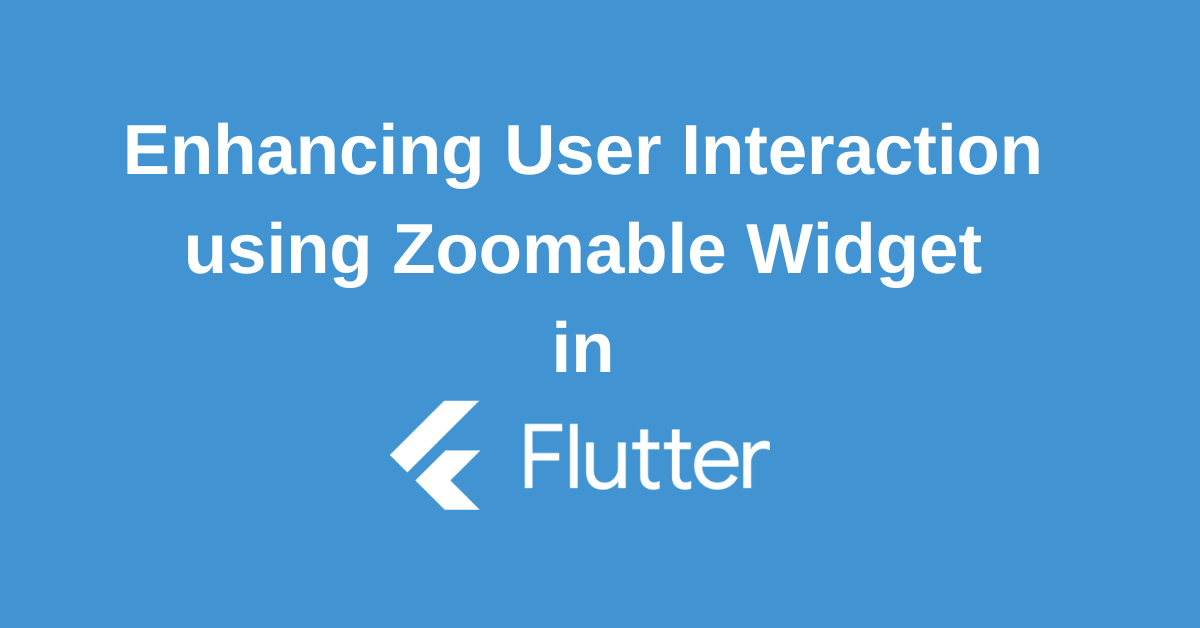In the world of mobile apps, a smooth and interactive user experience is paramount. Imagine allowing users to seamlessly zoom in on captivating images, intricate details, or informative charts within your Flutter app. This is where Flutter zoomable widget come into play! These powerful widgets empower you to integrate intuitive pinch-to-zoom functionality into your layouts, enhancing user interaction and engagement. This blog post will delve into the world of Flutter zoomable widgets, guiding you through their implementation and exploration of their potential to elevate your app’s user experience.
Setting Up the Flutter Zoomable Widget Environment
Before we delve into crafting Flutter Zoomable Widget in Flutter, let’s ensure our environment is primed for success. This involves two key steps: configuring your Flutter project to unlock zoom functionality and preparing your widget tree to handle those zoom interactions seamlessly. Get ready to empower your users with the ability to explore your app in stunning detail.
Initializing Your Flutter Project
To begin, create a new Flutter project or navigate to your existing root directory. The first step is to update your yaml file with the necessary dependencies. This includes adding the appropriate Flutter package that provides Zoom capabilities. Once you’ve updated the yaml file, run a package get command to import the new package into your Flutter project.
Setting Up a Zoomable Image Widget
// Import the necessary Flutter packages
import 'package:flutter/material.dart';
import 'package:zoom_widget/zoom_widget.dart';
// Inside your StatefulWidget's State class
@override
Widget build(BuildContext context) {
return Scaffold(
body: Zoom(
// Set the initial zoom properties
initZoom: 0.0,
// Define the child widget to be zoomable
child: Image.asset('assets/images/your_image.png'),
),
);
}Managing State for Zoom Interactions
To create a responsive and smooth zooming experience, managing the widget’s state is essential. This involves keeping track of details like the current zoom level, position within the zoomed content, and any other properties that change as users interact. Luckily, Flutter offers various state management solutions like Provider, Bloc, or even the simpler setState method. These tools empower you to efficiently handle these changes, ensuring your users can explore your app in a seamless and intuitive way.
Implementing the Zoom Functionality
With the groundwork laid, it’s time to bring the zoom magic to life! This next step involves crafting the code that listens for user gestures like pinching or tapping. Once it detects these interactions, the code will dynamically update the widget’s appearance, allowing users to explore your app in captivating detail.
Handling Zoom Gestures
The secret sauce behind smooth zooming lies in how you handle user gestures. Flutter’s robust gesture detection system comes to the rescue! Specifically, we’ll leverage its ability to recognize pinch and spread gestures, the intuitive motions users make to zoom in and out. By utilizing the onScaleUpdate callback, you can capture these gestures in real-time. As users pinch their fingers together or spread them apart, the code dynamically adjusts the scale of the child widget within the zoomable area, seamlessly translating their actions into a magnified or minimized view. This creates a highly responsive and intuitive zooming experience for your users.
Updating the Widget’s Scale and Position
As users explore your app’s content through zooming, we need to keep the widget’s appearance in sync with their interactions. This translates to dynamically updating the widget’s scale and position based on their gestures. Under the hood, this involves manipulating the widget’s transformation matrix. Flutter’s Matrix4 class provides the tools to apply these transformations, allowing for smooth scaling of the content. Optionally, you can even incorporate panning functionality using the matrix, empowering users to navigate around the zoomed-in area for a more comprehensive exploration. This combination of scaling and panning (if desired) creates a dynamic and user-controlled zooming experience.
// Import the necessary Flutter packages
import 'package:flutter/material.dart';
// Inside your StatefulWidget's State class
double _scale = 1.0;
double _previousScale = 1.0;
@override
Widget build(BuildContext context) {
return GestureDetector(
onScaleStart: (ScaleStartDetails details) {
_previousScale = _scale;
},
onScaleUpdate: (ScaleUpdateDetails details) {
setState(() {
_scale = _previousScale * details.scale;
});
},
onScaleEnd: (ScaleEndDetails details) {
_previousScale = 1.0;
},
child: Transform.scale(
scale: _scale,
child: Image.asset('assets/images/your_image.png'),
),
);
}Ensuring Performance During Zoom
Managing the widget’s state efficiently is important to maintain high performance during zoom operations. Avoid unnecessary rebuilds of the widget tree and consider using a dedicated state management approach to handle the zoom state. This will ensure that the app remains responsive and the zoom interactions are smooth.
Adding Additional Interactive Features
Beyond basic zooming, you should add more interactive features, such as double-tap to zoom or panning while zooming in. These features can enhance the user experience by providing more ways to navigate the zoomed content. Implementing these requires additional gesture handling and state management to keep track of the zoom center point and the current offset of the content
// Import the necessary Flutter packages
import 'package:flutter/material.dart';
// Inside your StatefulWidget's State class
double _scale = 1.0;
double _previousScale = 1.0;
Offset _doubleTapPosition = Offset.zero;
@override
Widget build(BuildContext context) {
return GestureDetector(
onDoubleTapDown: (TapDownDetails details) {
_doubleTapPosition = details.localPosition;
},
onDoubleTap: () {
setState(() {
_scale = _scale == 1.0 ? 2.0 : 1.0;
});
},
onScaleStart: (ScaleStartDetails details) {
_previousScale = _scale;
},
onScaleUpdate: (ScaleUpdateDetails details) {
setState(() {
_scale = _previousScale * details.scale;
});
},
onScaleEnd: (ScaleEndDetails details) {
_previousScale = 1.0;
},
child: Transform(
alignment: Alignment.center,
transform: Matrix4.identity()..scale(_scale)..translate(_doubleTapPosition.dx, _doubleTapPosition.dy),
child: Image.asset('assets/images/your_image.png'),
),
);
}Conclusion
In conclusion, Flutter zoomable widgets offer a powerful tool to elevate your app’s user experience. By incorporating pinch-to-zoom functionality, you empower users to explore details, interact with visuals in a more intuitive way, and ultimately feel more engaged with your app. This guide has equipped you with the knowledge to leverage Flutter’s zoomable widgets effectively. Remember to explore different packages, customize zoom behavior, and prioritize a smooth user experience. With zoomable widgets in your arsenal, you can create dynamic and interactive Flutter layouts that will captivate your users and keep them coming back for more.

